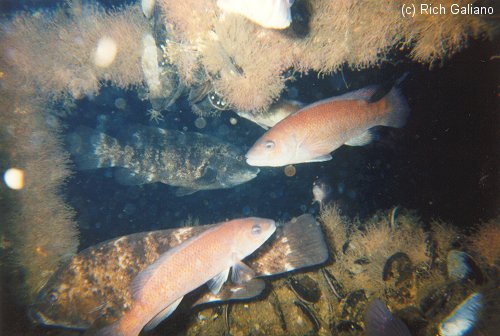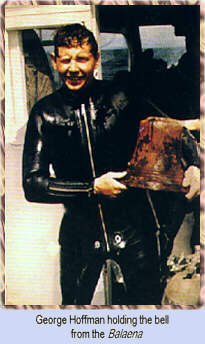Blackfish (2/2)
Tautog Fishing Has Been Great, So Why More Restrictions?
By Peter Himchak, Supervising Biologist
New Jersey anglers were pro-active in tautog management long before the Atlantic States Marine Fisheries Commission ( ASMFC ) Interstate Fishery Management Plan (FMP) for Tautog was adopted in March 1996. The New Jersey Marine Fisheries Council (MFC) formed a Tautog Committee in the mid-1980s bringing together recreational and commercial fishermen, divers, council members, and Division of Fish and Wildlife staff to develop a New Jersey management plan for tautog which would promote a sustainable fishery and maintain the historical harvest allocation between recreational and commercial fishermen. The Tautog Committee showed keen vision in designing a step-wise increase in the minimum size limit and establishing an annual commercial harvest quota of 103,000 pounds ( 10% of New Jersey's annual harvest at that time, ) a strategy acceptable to all user groups. The anglers, in fact, requested an accelerated increase in the proposed minimum size when the proposal went out to a public hearing. At the time, all user groups were happy, enthusiastic, and working together, a resource manager's dream.
The ASMFC Tautog Technical Committee started meeting in the mid-l990s, charged with the task of developing an interstate fishery management plan. Upon adoption in 1996, the FMP required states from Massachusetts to North Carolina ( the range of the fish ) to establish a minimum possession size of 14 inches to increase spawning stock biomass and implement effort controls to meet fishing mortality rates established to rebuild the stock and prevent overfishing. New Jersey's Tautog Committee strategy was now supplanted by the requirements of the ASMFC FMP. Recreational and commercial fishermen and divers again made sacrifices, now being constrained by bag limits and seasons. The 14inch minimum possession limit implemented in April 1998 initially restricted the harvest severely in all fisheries, particularly shore based anglers, and the one fish bag limit during warm weather months hurt divers and sportfishermen alike. The closed seasons in the commercial fishery substantially reduced its harvest, as well. The years 1996 through 1999 represented a real drought in harvesting tautog anywhere in the state.
These sacrifices were good investments and the tautog spawning stock biomass rebounded tremendously. The coast-wide fishing mortality rate calculated in 1999 ( F=0.22 ) showed that fishing mortality was highly reduced from previous years and in line with the FMP fishing mortality target ( Interim F=0.24 ) the 14-inch minimum possession limit was effective in protecting several year classes from harvest and hopefully, the effort controls ( bag limits and seasons ) would control fishing mortality when these year classes crossed the 14-inch threshold. The 2000 fishing season for recreational anglers was great and they, at least, were happy. Commercial fishermen, unfortunately, were still required to release many legal size fish during closed commercial seasons.
Delight turned to dismay when the coastal stock assessment was updated following the 2000 season and fishing mortality was shown to have increased substantially to F=0.41, reversing the gains made throughout the previous years. Production of young fish from the 1999 and 2000 year classes was excellent but the high fishing mortality on older fish had eroded the spawning stock biomass. Apparently, the effort had not been sufficiently controlled to continue the reduction in the fishing mortality rate. Since the FMP target is F=0.29 and the current fishing mortality rate was measured as F=0.41, a 49% reduction in fishing mortality would now be required to meet the FMP goal. Such a reduction would be socially and economically devastating. Now, what do we do?
Complicating an already confusing management situation has been the growth of a substantial illegal commercial fishery. The live fish market and the increased availability of tautog have provided an economic incentive for some non-permitted anglers to sell their catch. Several years ago, a quota-based, limited entry commercial fishery was established for the historical participants in the commercial tautog fishery. Both directed fishery and non-directed fishery tautog permits were issued to qualifying commercial fishermen who generated the commercial landings used as the basis of the quota. At the present time, only 57 individuals in the state have been issued a tautog permit and are allowed to take tautog for purposes of sale. Any non-permitted fisherman taking tautog by any means for purposes of sale is participating in an illegal commercial fishery. Marine enforcement agents have issued many summonses for this illegal activity which has become widespread along the New Jersey coast. This illegal harvest not only harms the resource but may be inflating the enormous harvest estimate for the recreational fishery.
The fishing community is at a crossroads again on tautog management. Addendum Ill of the FMP has been through the public hearing process. The public comment period that lasted until February 15, 2002, afforded all interested parties to voice their preference on a number of options setting the future course of interstate management of tautog. The ASMFC Tautog Management Board (Board) met February 18, 2002, and reviewed the scientific recommendations and all the public comments on Addendum III before deciding the best course of action to take in 2002 and in future years.
The Board approved Addendum III with the following management requirements:
- States must maintain current or more restrictive fishing regulations during 2002.
- By April 1, 2003, states must implement regulations to reduce fishing mortality in the recreational fishery by approximately 48%. Such reductions will be achieved in lower bag limits, shorter seasons, or a combination of both.
- The ASMFC Law Enforcement Committee will investigate and assess the magnitude of unreported landings, both for the live market and from non-directed gear ( i.e., bycatch ) and report back to the board during 2002.
While the Board maintained its support for the coast-wide tautog stock assessment through a Virtual Population Analysis approach, it placed additional requirements on states to enhance data collection and monitoring programs coast-wide. Improved data collection programs would provide for regional stock assessments and allow states more flexibility in designing management measures.
The Board further recommended that the Federal government adopt management measures in the Exclusive Economic Zone (EEZ), 3-200 nautical miles offshore, which are in accordance with states' minimum sizes, bag limits, seasons, and other landings requirements. At the present time, there are no federal management measures for tautog in the EEZ.
After extensive dialogue among all user groups, scientists, and managers, a future course of action has been set for the management of tautog. More data must be collected and more sacrificing must be endured to restore this valuable resource. Let's hope for the best for both the fish and the fisherman.
Reprinted from NJ Fish & Wildlife Digest 2002 Marine Issue


